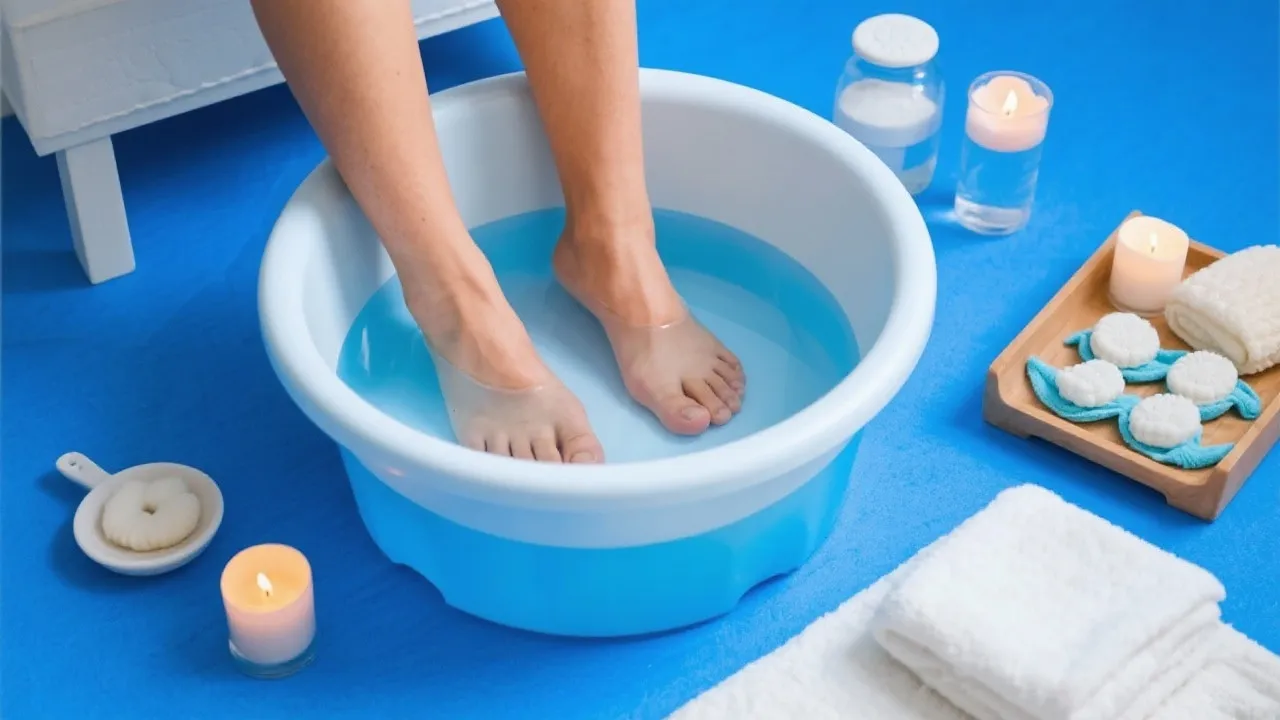Exploring the Neuropathy Foot Bath Benefits
Discover the therapeutic benefits of the Neuropathy Foot Bath, designed to alleviate symptoms associated with peripheral neuropathy. This therapeutic practice has gained popularity for its potential to offer relief from pain, numbness, and tingling in the feet, characteristic of neuropathy. This article delves into the intricacies of how foot baths function, their components, and the potential health improvements they may offer.

Understanding Neuropathy and Its Implications
Peripheral neuropathy is a condition characterized by damage to the nerves outside of the brain and spinal cord, leading to symptoms like pain, numbness, and tingling, particularly in the extremities such as the feet. This condition can arise from various causes, including diabetes, infections, inherited disorders, and exposure to toxins. The increasing prevalence of peripheral neuropathy in modern lifestyles is alarming, with factors such as sedentary habits, poor diet, and certain medications playing a significant role in its onset. As awareness of neuropathy grows, various treatment modalities are being explored, including the Neuropathy Foot Bath, which is emerging as an adjunct supportive therapy aimed at mitigating these distressing symptoms. By understanding neuropathy and its implications, individuals can better navigate their treatment options and improve their quality of life.
The Epidemiology of Neuropathy
The prevalence of peripheral neuropathy is estimated to be around 2-8% of the general population, but this figure can rise dramatically in high-risk groups. For instance, studies suggest that up to 50% of individuals with diabetes will develop some form of neuropathy, notably diabetic neuropathy. The condition can significantly impact everyday activities, where patients often experience debilitating pain, sensitivity to touch, and impaired proprioception, a system that helps the body sense its position and movement in space.
Furthermore, conditions such as chemotherapy-induced peripheral neuropathy (CIPN) affect nearly 30-40% of cancer patients undergoing certain types of chemotherapy. This makes neuropathy a critical area for research and therapeutic intervention. The understanding of neuropathy's impact is essential not only for the patient but also for caregivers and healthcare providers who are tasked with managing the complexities of this condition.
The Science Behind Neuropathy Foot Baths
Neuropathy Foot Baths are designed to immerse the feet in warm water infused with minerals and essential oils that potentially aid in nerve stimulation and recovery. The principle behind this therapy lies in hydrotherapy, which utilizes temperature and pressure in water to relieve pain and enhance circulation. Clinical studies suggest that warmth applied to the feet can effectively increase blood flow, leading to improved oxygenation and nutrient delivery to damaged nerve tissues. Epsom salts, known for their magnesium-rich composition, are commonly added to these baths due to their reputed abilities to reduce inflammation and ease discomfort.
Magnesium sulfate, the chemical compound found in Epsom salts, plays a fundamental role in various biochemical reactions in the body. When absorbed through the skin during a warm foot bath, magnesium can help modulate the levels of neurotransmitters, which may subsequently help alleviate pain signals in neuropathy patients. Additionally, essential oils like lavender, known for their calming and soothing properties, can enhance the therapeutic effects of foot baths, potentially providing a dual-action benefit of relaxation and pain relief.
Components of an Effective Neuropathy Foot Bath
- Warm Water: Acts as a soothing agent, easing muscle tension and enhancing circulation. The optimal temperature for foot baths is around 92-98°F (33-37°C), providing a warm, yet comfortable sensation that can promote relaxation.
- Epsom Salts: Provide magnesium that may reduce chronic inflammation. Incorporate approximately 1-2 cups of Epsom salts per foot bath to experience beneficial effects effectively.
- Essential Oils: Oils such as lavender or peppermint can offer calming and analgesic properties. Adding around 5-10 drops of essential oil to the warm water can enhance the foot bath experience, contributing both aroma therapeutic benefits and potential pain relief.
- Foot Scrubs or Exfoliants: Consider adding natural exfoliants to the routine (such as sugar or sea salt) which can not only soften the feet but also stimulate blood circulation during the soaking process.
- Optional Herbal Additives: Ingredients such as chamomile, ginger, or rosemary can further enrich the bath. Chamomile is known for its anti-inflammatory properties, while ginger can improve circulation and alleviate muscle soreness.
Therapeutic Effects
Research suggests that regular use of a Neuropathy Foot Bath can promote vascular health by improving blood flow to areas affected by neuropathy. Enhanced circulation not only supports the nourishment of damaged nerves but also helps in the removal of metabolic waste. This physiological response can potentially reduce the severity of symptoms such as swelling and pain.
Moreover, foot baths can induce a substantial relaxation response, which may help in managing stress levels that often accompany chronic pain. Prolonged exposure to stress can exacerbate the pain and discomfort associated with neuropathy, creating a cyclical pattern that can be difficult to break. By integrating Neuropathy Foot Baths into the overall self-care routine, individuals may find relief from not only the physical symptoms but also the emotional component of living with neuropathy.
Additionally, the use of hydrotherapy in neuropathy management allows for a non-invasive treatment approach, making it particularly appealing to those who are wary of pharmaceuticals or invasive medical procedures. As with any treatment, ongoing assessment and communication with healthcare providers are crucial, ensuring that any changes in symptoms or overall health are properly recorded and discussed.
Integrating Foot Baths into Daily Routine
Incorporating a foot bath into a regular self-care routine can be straightforward and rewarding. It is recommended to soak the feet for 15-30 minutes, two to three times a week. This practice, combined with other therapeutic interventions such as physiotherapy, can be more effective in managing the symptoms of neuropathy over time. Having a specific time dedicated to foot baths can help create a ritualistic approach to self-care, fostering a sense of mindfulness and relaxation.
When integrating foot baths into your routine, it might be useful to create a calming environment. Consider factors such as soft lighting, soothing music, and a comfortable chair or bench. Additionally, engaging in light activities like reading or journaling during the foot bath can enhance relaxation and make the experience more enjoyable.
As part of a holistic therapeutic regimen for managing neuropathy, it's essential to pair foot baths with other lifestyle changes as well. Regular physical activity, balanced nutrition, and stress management practices (such as yoga or meditation) contribute to a comprehensive health plan that can mitigate the effects of neuropathy significantly. Establishing a collaborative plan with healthcare professionals can identify the best combination of treatments and routines tailored to individual needs.
Neuropathy Foot Bath: Comparative Analysis
| Method | Key Features |
|---|---|
| Neuropathy Foot Bath | Hydrotherapy-based relief, enhances circulation, uses Epsom salts and essential oils. Safe and non-invasive. |
| Medication | Pharmaceutical intervention for symptom management, often includes oral medications and topical treatments; potential for side effects and dependency. Includes prescribed medications such as pregabalin or gabapentin. |
| Physical Therapy | Exercises and movements targeted at improving mobility and reducing pain. Involves personalized treatment plans that may include strength training and stretches. |
| Alternative Therapies | Includes acupuncture, chiropractic care, and herbal medicine, which may provide relief through different physiological mechanisms. Can be integrated with traditional treatment plans. |
FAQs
- What is peripheral neuropathy?
Peripheral neuropathy is a disorder caused by damage to the nerves located outside the brain and spinal cord, leading to a variety of debilitating symptoms. - How does a Neuropathy Foot Bath work?
The bath uses warm water, Epsom salts, and essential oils to improve circulation and reduce pain and inflammation, providing both physical and emotional relief. - Are there any risks associated with foot baths?
Generally considered safe, but individuals with specific health conditions should consult their healthcare provider before use. Special care should also be taken to avoid slips or falls when entering or exiting the bath. - Can foot baths be combined with other treatments?
Yes, Neuropathy Foot Baths can complement other therapies such as medications, physical therapy, and alternative treatments, potentially enhancing the overall effectiveness of treatment plans. - How should I prepare for a foot bath?
Ensure you have a clean, comfortable space, gather your materials (Epsom salt, essential oils, towels), and consider setting the atmosphere to promote relaxation.
Conclusion
The utilization of a Neuropathy Foot Bath offers a complementary approach to managing neuropathic symptoms and enhancing overall foot health. While it should not replace conventional treatments, integrating it as part of a holistic care plan may provide notable relief and improve quality of life for those affected by peripheral neuropathy. As research continues to delve into alternative therapies, the future holds promise for broader applications of hydrotherapy and similar methods in treating various forms of neuropathy and related conditions.
Additional Considerations
Moreover, patients exploring Neuropathy Foot Baths should remain conscious of the broader lifestyle impacts that accompany nerve damage. Emotional health, for instance, plays a critical role in managing chronic conditions like neuropathy. Patients might experience feelings of frustration or despair as they contend with persistent discomfort. Thus, incorporating supportive activities such as counseling or joining support groups tailored for those experiencing similar challenges can provide not only emotional backing but also practical advice for navigating day-to-day living with neuropathy.
Additionally, engaging in regular monitoring of your condition, including keeping a symptom diary, can be enormously beneficial. This record may aid healthcare providers in assessing the effectiveness of various treatments, including foot baths, and making necessary adjustments to management plans. It also helps in identifying potential triggers or patterns related to worsening symptoms, which can lead to the development of proactive strategies to mitigate these triggers.
Lastly, hydration plays an essential role in maintaining nerve health and should not be overlooked. Adequate water intake throughout the day, along with electrolyte balance, contributes positively to vascular health and overall well-being. Pairing your foot bath routine with proper hydration supports the goal of nourishing nerves and enhancing recovery, ensuring that you're taking a multifaceted approach to managing neuropathy.
In conclusion, implementing Neuropathy Foot Baths as part of a comprehensive, multi-dimensional treatment strategy not only underscores the importance of holistic wellness in chronic pain management but also empowers individuals in their journey toward better health and enhanced quality of life. Through informed and thoughtful integration of therapies and lifestyle adjustments, patients can find relief, reclaiming not only their comfort but fostering a renewed sense of hope.





